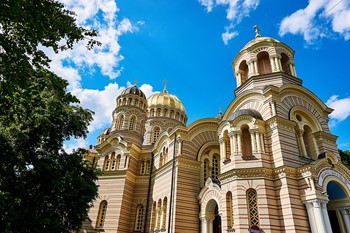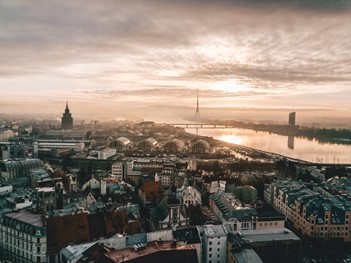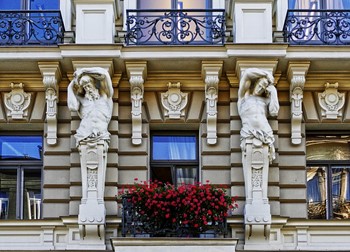Things to do in New Riga
The part of the Latvian capital known as New Riga or Centrs, sits to the northeast of Old Town and it is the Central District of the city. Separated from Old Town by the City Canal, Centrs is known for its many art nouveau buildings and is a great place to do some sightseeing.
Freedom Monument
This monument at the centre of the city was unveiled in 1935 as a memorial to those who fell in Latvia's struggle for independence. Completely funded by donations from residents, it represents Latvian statehood, national unity, independence and freedom.
The almost 43 metre high monument consists of 56 sculptures, divided into 13 groups on four levels, which depict Latvian history and culture. The monument is topped by a nine metre high sculpture of a young woman holding three stars above her head, which symbolise the three historic provinces of Latvia. At the base of the monument stands a two-man honour guard, symbolising Latvia's sovereignty.
Riga Nativity of Christ Orthodox Cathedral
Riga's largest Orthodox church survived the Soviet-era as a planetarium and restaurant but now once again serves as it was intended to do when it was build in the 19th century. However the damage that was done has not been completely restored yet.
The original design for the cathedral did not include a separate belfry, however when the Russian Czar Alexander II gifted twelve bells an extra dome for the bells was added. The cathedral follows the Neo-Byzantine style with six domes, two of which are painted gold. The Nativity Cathedral is renowned for its icons.
Esplanade park
The Nativity of Christ Cathedral sits on the eastern edge of Esplanade park. This nearly 9 hectares park was once a hill, used by enemies of the city as a staging point, until it was levelled by military decree in the 18th century. After citizens grew accustomed to its pavilions during Riga's 700th anniversary in 1901, it became a de facto park.
Today its lawns and shady paths have turned the park into a popular meeting point in the city with kids' attractions and cold drinks in the summer. The park has statues of the Latvian army's first commander-in-chief, Oskar Kalpaks, and renowned author Rainis.
National Museum of Art
On the opposite site of Esplanade park to the cathedral sit Latvia's National Museum of Art and the country's Art Academy. The building of the Art Acadamy has always been a school, though not always for art. A Neo-Gothic style was chosen to represent historic commercial ties and to serve as a reminder of the city's former membership of the Hanseatic League.
The Latvian National Museum of Art exhibits the country's largest collection of professional art. The building was the first ever to be built in the Baltic States specifically for art in 1905. The museum was completely renovated before reopening in May 2016. Today both the art on display and the building itself attract many visitors.
Central Market
On the banks of the Daugava you'll find Riga's Central Market, which was first opened in 1930. To this day it is Europe's largest marketplace at a little over 72 hectares and it was placed on the UNESCO World Heritage site list in 1998.
The Central Market was constructed out of five zeppelin hangars, originally used by the German army. These hangars are five of nine zeppelin hangars that still remain in the world. The architecture of the market was influenced by practical need as well as Neoclassicism. Each hangar is home to a different pavilion: the vegetable, dairy, meat, fish and gastronomic pavilion, the open market, the Industrial Goods Market, the night market and the Farmers' Day Market.
Bastion Hill
This park, which surrounds the City Canal, is locally known as Bastjkalna Park. The City Canal (Pilsētas kanāls) was once the city's old moat, which protected Old Town from invaders. Today the park is considered by some as one of the most romantic spots in the city ,with its many narrow paths, tree lined boulevards, a stone garden and waterfalls.
Yet the park also includes monuments to remind visitors of tragic events in Latvia during the 20th century. Such as the five red stone slabs in memorial to the victims of 20 January 1991, when Soviet Union troops stormed the nearby Interior Ministry. And a statue of Rūdolfs Blaumanis, which was erected in 1929, marks the spot where Jews were chased and beaten when Nazi's occupied the city.
Art Nouveau district
Over a third of all buildings in Riga are examples of the Art Nouveau, or Jugendstil, style of design. This makes Riga the city with the highest concentration of art nouveau architecture in the world. The main reason for this abundance is that the style was at the height of its popularity when Riga went through an unprecedented financial boom.
Art Nouveau was often inspired by natural forms such as the sinuous curves of plants and flowers. Albert Street especially is a gem for Riga art nouveau sightings. Each building there is unique and eight of the buildings on the street have officially been designated as architectural landmarks.
Latvian National Theatre
The Latvian National Theatre is not only a beautiful building and one of the leading professional repertoire theaters in the country. It is also an historical site, as it was here that, in November 1918, the People's Council and Government gathered to proclaim the the Republic of Latvia as the country declared its independence from the German empire.
Today the theatre has three auditoriums which can host anywhere between 70 to 700 spectators. On of the theatre's traditions is to close each season with a performance of Rūdolfs Blaumanis' "Skroderdienas Silmači". Blaumanis is one of Latvia's greatest writers, another of his famous work is the short story 'In the Shadow of Death'.
